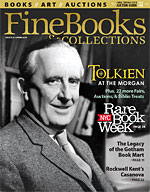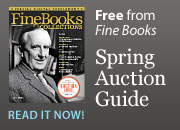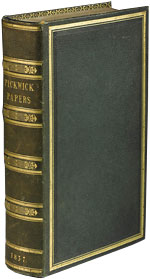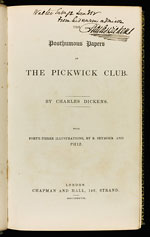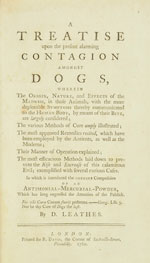 Ian McKay’s weekly column in Antiques Trade Gazette has been running for more than 30 years.
Ian McKay’s weekly column in Antiques Trade Gazette has been running for more than 30 years. A High Horse and a Teller of Tales
Our Mutual Friends in Admiration
Presentation copies of The Posthumous Papers of the Pickwick Club and The Life and Adventures of Nicholas Nickleby by Charles Dickens, £67,250 ($104,675) each at Sotheby’s London on December 16.
In 1838, the poet and writer Walter Savage Landor wrote to John Forster, a mutual friend and future biographer to both men, asking him to tell Dickens that “he has drawn from me more tears and more smiles than are remaining to me for all the rest of the world, real or ideal.” But it was not until 1840 that the two men actually met, at the home of Lady Blessington.
Shortly thereafter, and perhaps on one of the frequent visits that Dickens and Forster then made to Landor in Bath, Dickens gave his admirer these inscribed copies of Pickwick and Nicholas Nickleby.
The earlier book is an 1837 first edition, but later issue with 1838 title page, and Nicholas Nickleby again a first of 1839, but both are in special publisher’s bindings of green morocco gilt that were prepared for a number of Dickens’ books around this time, and both were inscribed: “Walter Savage Landor from his warm admirer Charles Dickens” on the title pages.
Landor’s literary reputation has not weathered so well as he might have hoped, but he has the distinction of having been immortalized by Dickens in Bleak House, where his eccentric, pugnacious, and somewhat irascible nature is portrayed in the character of Lawrence Boythorn.
The books were sold by one of Landor’s descendants.
A Deplorable Dog Story
A Treatise Upon the Present Alarming Contagion Amongst Dogs, by D. Leathes, £1,469 ($2,340) at Dominic Winter of South Cerney on January 26.
The auctioneers could locate only two copies in English institutional collections and another in the library of the New York Academy of Medicine, so this would appear to be quite a canine rarity.
The full title continues “…wherein the Origin, Nature, and Effects of the Madness, in those Animals, with the more deplorable Symptoms thereby communicated to the Human Body, by means of their Bite, are largely considered; the various Methods of Cure amply illustrated…” and also brings news of an “Antimonial-Mercurial-Powder which has long engrossed the Attention of the Publick.”
Like the saleroom, I failed to find more on Leathes, but I did find a contemporary review of the book in The Monthly Review. The work is described by the reviewer as consisting “chiefly of a collection of a various methods of cure,” but his splendid introductory paragraph gives the background to its publication:
“The general and ridiculous panic which prevailed about the end of last summer, concerning Mad Dogs, and the extraordinary artifices employed to propagate and increase it, are still recent in everyone’s remembrance … how the daily Papers were continually filled with reports of persons bitten by Dogs being Dead, or sent to bathe in the sea, &c. for their recovery; how many of his Majesty’s liege subjects … prudently confined themselves to their houses, while others, more daring and adventurous … walked the streets in jack-boots, armed with clubs and other offensive weapons, breathing bold defiance to the whole canine race.”
A first edition of 1760 in a contemporary tree calf binding and bearing the author’s presentation inscription to the Honorable Lady Stapleton, it was bought by Californian dealers B & L Rootenberg.


